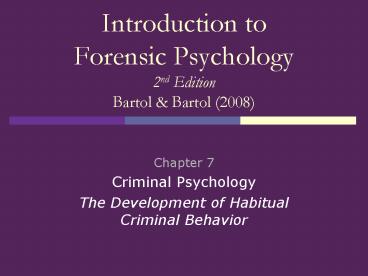Introduction to Forensic Psychology 2nd Edition Bartol - PowerPoint PPT Presentation
1 / 15
Title:
Introduction to Forensic Psychology 2nd Edition Bartol
Description:
... delinquency, one must view it as progressing along at least two developmental paths ... Developed by Robert Hare, Professor Emeritus, University of British ... – PowerPoint PPT presentation
Number of Views:442
Avg rating:3.0/5.0
Title: Introduction to Forensic Psychology 2nd Edition Bartol
1
Introduction toForensic Psychology2nd
EditionBartol Bartol (2008)
- Chapter 7
- Criminal Psychology
- The Development of Habitual Criminal Behavior
2
Juvenile Offender
- Imprecise, social, clinical and legal label for a
broad spectrum of low- and norm-violating
behavior - Delinquency is behavior against the criminal code
committed by an individual who has not reached
adulthood - Status offenses are acts that are prohibited only
for juveniles (e.g., running away, violating
curfew laws, and truancy) - Psychological or psychiatric definitions of
delinquency include the symptom-based labels such
as Conduct Disorder
3
Conduct Disorder
- Diagnostic and Statistical Manual of Mental
Disorders classification. Children diagnosed with
Conduct Disorder display antisocial behavioral
symptoms such as - Stealing
- Setting fires
- Running away from home
- Skipping school
- Destroying property
- Fighting
- Being cruel to animals and people
- Frequently telling lies
4
Firesetting Typologies
- Curious
- Pathological
- Expressive
- Delinquent
5
School Violence
- Columbine High School
- Threat Assessment
- Identifiable targets
- Does not rely on descriptive, demographic or
psychological profiles - Does not rely directly on verbal or written
threats as a threshold for risk - Making a threat v. posing a threat
- Direct
- Indirect
- Veiled
- Conditional
6
Developmental Perspective
- Serious persistent delinquency patterns and adult
criminality begin in early childhood and follow a
particular path or trajectory - Emphasizes the neurological, biological, mental,
emotional, and social changes in children and its
influence on criminality - Factors
- Hyperactive-impulsive-attention problems
- Conduct problems
- Deficient cognitive ability
- Poor interpersonal and social skills
- Poor language development
7
Biology
Biological Factors
- Plays an important role in criminal behavior
however biological factors do not act in
isolation and interact with environmental factors
in the development of antisocial, delinquent, and
criminal behavior.
- Brain Chemistry
- Dopamine
- Frontal lobes
- Serotonin
- Hormones
- Androgen testosterone
- cortisol
- Temperment
- Genetic Influence
- Twin and adoption studies
8
Moffitts Theory
- To understand delinquency, one must view it as
progressing along at least two developmental
paths - Lifelong trajectory of delinquency
- Age 3
- Anti-social behavior
- LCP
- Neurological problems during childhood
- Violent and aggressive crimes
- Do not learn prosocial and interpersonal skills
- Poor environmental conditions
9
Moffitts Theory (Continued)
- Adolescent limited offender
- Peer and social factors
- Environmental factors
- Temporary offending
- AL
- Do not demonstrate early and persistent
antisocial problems - Crimes that symbolize adult privilege and
demonstrate autonomy from parental control - Vandalism
- Drugs
- alcohol
10
Coercion Developmental Model
- Gerald Patterson
- Focuses on the impact of parenting and
characteristics of the child - Early Starter
- Arrest before age of 14
- Adult crime
- Late Onset
- Arrest after the age of 14
- Desistance from adult crime
11
Control Theory
- Travis Hirschi (1969)
- Social control theory
- Hirschi Gottfredson (1991)
- Self control theory
- Catalano Hawkins (1996)
- Seattle Social Development Model
12
The Criminal Psychopath
- Selfish
- Inability to love
- Deceitfulness
- Lack of guilt
- Lack of empathy
- Antisocial Behavior
- Low anxiety proneness
- Poor judgment
- Superficial charm
- No life plan
- Unreliability
- High recidivism
Approximately 1 of the general population and
15-25 in the prison population are psychopaths
13
Assessment of Psychopathy
- Psychopathy Checklist-Revised (PCL-R)
- Developed by Robert Hare, Professor Emeritus,
University of British Columbia - Designed to measure the construct of psychopathy
for research purposes - Used clinically to predict dangerousness as a
result of empirical findings that show a link
between high PCL-R scores and general and violent
recidivism - Variations of the Psychopathy Checklist
- Psychopathy Checklist Screening Version (PCL-SV)
- Psychopathy Checklist Youth Version (PCL-YV)
- P-Scan Research Version
14
Psychopathy and Gender
- Minimal research has been conducted on the extent
to which psychopathy exists in females. - It has been generally assumed and some research
supports that males far outnumber their female
counterparts. - There is some preliminary evidence that female
psychopaths may be - Less aggressive and violent than male psychopaths
- Recidivate less often than male psychopaths
15
Psychopathy and Race/Ethnicity
- Research suggests that African American criminal
psychopaths tend to be less impulsive than white
criminal psychopaths. Other research shows no
significant racial-ethnic differences. - Criticism has been raised regarding
- Whether or not it is appropriate to use the PCL-R
with African American inmates. - Whether the stigmatizing diagnosis of psychopathy
is likely to be used in a biased manner among
minority or disadvantaged groups































